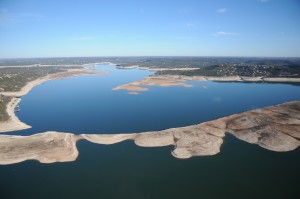5 Ways to Find Water for a Thirsty Texas

Photo by LCRA
The extreme drought has lowered levels in Lake Travis, exposing formations not seen for some time.
As rains fall at above-average levels in much of the state in recent months, people are starting to ask the question: “Is the drought over?” (In fact it’s a search term that often leads to this site.)
No, it isn’t. Far from it. Just this week a town outside of Austin ran dry. But overall drought conditions are improving, and if weather forecasters are correct, the patterns that have caused the drought could begin their exit as early as March.
And that worries people like Tom Mason, an environmental lawyer and former head of the Lower Colorado River Authority, which manages water for much of Central Texas. He says that Texas goes through cycles of comfort with water, then panic during drought, and finally forgetfulness once it has abated. Mason worries that once the current drought ends, we could soon forget how bad it was and fail to act now to plan for potentially even worse droughts in the future.
Mason spoke yesterday at the Driskill Hotel in Austin on the new water plan currently being considered for the state, and how Texas can handle more people and less water. Here are five things he noted about the water plan, which has a price tag of $53 billion and would provide Texas enough water until 2060, even through another drought of record:
- Conserve, Conserve, Conserve. Nearly a quarter of the new water for Texas will come from saving the water we already have in the new plan. “It’s the fastest and cheapest way to make more water,” Mason says. And there’s little opposition to conservation, except for one: bad habits. “We Texans love long showers and green St. Augustine lawns in August,” Mason notes. But if Texas is to have water security, he says, our ways will have to change. San Antonio, he points out, has reduced its water usage by 42 percent over the last few decades, despite one of the fastest-growing populations in the country. Most of that conservation comes from new “the more you use, the more you pay” water pricing, repair of leaky pipes, and giving away water-efficient toilets. More regular, stringent water restrictions also helped the city conserve.
- Set a Trap. That’s essentially what water reservoirs do, and in the new water plan there is around 1.5 million acre-feet of Texas’ future water supply that will come from reservoirs, around 17 percent of our new water supply. There’s just one problem, according to Mason: “There’s not a lot of good reservoir sites left in Texas.” New dams are “extremely” expensive, and federal funding for those projects are almost nonexistent now. Add in the “protectionist” nature of Texas property rights and the situation becomes even more difficult. But there’s one solution, he says: “off-channel reservoirs,” which are essentially huge ponds built off the side of rivers to store water from excess rains and floods that can later be used during drought.
- Start Digging. There’s a lot of water underneath the parched Texas earth, in places like the Carrizo and Edwards aquifers. Groundwater makes up nine percent of the new projected water supply. The question is how to get to it, and once you do, who owns it? While surface water is owned by the state, groundwater is a form of private property, Mason says. Because of the “rule of capture,” a law imported from England (not exactly known for its dry conditions), owners can pump as much as they like from groundwater on their property. Essentially, Mason says, “the biggest straw wins.” Texas is the only western state that allows this. “We’re going to have to work through that issue,” he says. A case currently in the Texas Supreme Court gets to the heart of it, Mason says, and could have “huge ramifications” for how the state decides who actually owns groundwater.
- If it’s Brown, Drink it Down. “I’m glad you’ve finished your meals,” Mason jokes when introducing the concept of water reuse. Every summer, when water becomes scarce, “everyone in Houston drinks [treated wastewater] from Dallas/Fort-Worth,” he says. In thirty years, sixty percent of Texans will be drinking it. “That’s the good news,” Mason says. “The bad news is that there won’t be enough to go around.” There are currently disputes in Austin, Dallas/Fort Worth and Waco over sourcing “treated effluent.” But people pay thousands of dollars per acre-foot for it (one acre-foot is equivalent to 236,000 gallons) in Western states, Mason notes, where drinking treated wastewater is the norm.
- Pass the Saltwater. There is a lot of brackish groundwater in Texas, which is easier to desalinate and treat than seawater, Mason says. But it’s still an expensive process (mostly due to the energy required), which costs as much as two to eight times higher than treating freshwater. El Paso is the poster child for desalination in the state, with a 100-year capacity of saltwater underground that it can treat. That’s a hundred years if it could no longer get water from any other sources.


